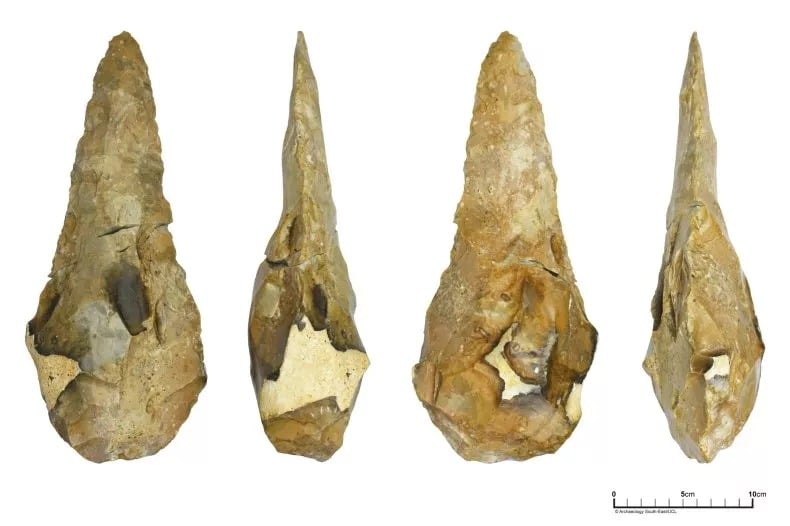
An incredibly old and enormous handaxe, believed to be around 300,000 years old, has been unearthed in Kent, a region in Southeast England. The discovery was made during excavation work preceding the construction of a new school.
A team of researchers from University College London Archaeology South-East has identified this tool and several other handaxes as one of the largest examples ever found in Britain. The sheer size of this artifact makes it quite challenging to handle.
Letty Ingrey, a senior archaeologist from the University College London Institute of Archaeology, shared insights with Newsweek regarding the potential age of these tools.
Ingrey explained that they likely date back to an interglacial period approximately 300,000 to 330,000 years ago. During this era, early Neanderthal populations are believed to have inhabited Britain.
It is possible that other ancient human species also roamed the area. However, no fossil evidence from the site has been uncovered, making it difficult to determine the exact creators of these tools.
Axes found at different archaeological sites
Throughout Africa and Europe, handaxes have been discovered at various archaeological sites dating back from 1.7 million to 300,000 years ago.
According to Ingrey, these handaxes served as cutting tools and were used for tasks such as animal butchering and meat preparation. During this era, our ancestors likely hunted animals like horses, red deer, and even straight-tusked elephants.
Ingrey explains that the handaxes formed just one part of a broader toolkit, including sharp flakers and scrapers.
While only stone tools made from flint have been preserved at this particular site, evidence from other locations suggests that people of this time would have utilized wooden spears and potentially other implements crafted from bone or wood, which unfortunately did not survive at this specific site.
Remarkable features of ice age axe
While handaxes from this period are commonly found in archaeological sites, the recently discovered large handaxe in Kent stands out as an exceptional find.
The most remarkable aspect of this particular handaxe is its size. Measuring approximately 29.6 centimeters (nearly a foot) in length, it ranks as the third-longest handaxe ever found in Britain. The reason behind the creation of such massive handaxes remains uncertain, as they appear too large to be easily wielded.
One of the stories I’m working on today – hear my report on the bulletins @BBCRadio2 and @BBCRadio4 today – massive ice age axe head discovered pic.twitter.com/19LHgtJ3c6
— Clare Runacres (@ClareNews2) July 6, 2023
The site where this significant discovery was made was only recently uncovered during excavations conducted prior to the construction of the Maritime Academy School in Frindsbury, Kent.
Ingrey said, “We started fieldwork and found the first artifacts in 2021, and finished fieldwork earlier this year. We have over 800 artifacts from this site. However, analysis of the collection and the site is still ongoing so we’ll be sharing information on the rest of the collection in the future.”
See all the latest news from Greece and the world at Greekreporter.com. Contact our newsroom to report an update or send your story, photos and videos. Follow GR on Google News and subscribe here to our daily email!



